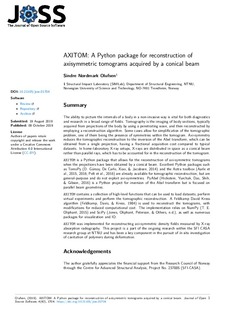| dc.description.abstract | The ability to picture the internals of a body in a non-invasive way is vital for both diagnostics and research in a broad range of fields. Tomography is the imaging of body sections, typically acquired from projections of the body by using a penetrating wave, and then reconstructed by employing a reconstruction algorithm. Some cases allow for simplification of the tomographic problem, one of them being the presence of symmetries within the tomogram. Axi-symmetry reduces the tomographic reconstruction to the inversion of the Abel transform, which can be obtained from a single projection, having a fractional acquisition cost compared to typical datasets. In home-laboratory X-ray setups, X-rays are distributed in space as a conical beam rather than parallel rays, which has to be accounted for in the reconstruction of the tomogram. AXITOM is a Python package that allows for the reconstruction of axi-symmetric tomograms when the projections have been obtained by a conical beam. Excellent Python packages such as TomoPy (D. Gürsoy, De Carlo, Xiao, & Jacobsen, 2014) and the Astra toolbox (Aarle et al., 2015, 2016; Pelt et al., 2016) are already available for tomographic reconstruction, but are general-purpose and do not exploit axi-symmetries. PyAbel (Hickstein, Yurchak, Das, Shih, & Gibson, 2016) is a Python project for inversion of the Abel transform but is focused on parallel beam geometries. AXITOM contains a collection of high-level functions that can be used to load datasets, perform virtual experiments and perform the tomographic reconstruction. A Feldkamp David Kress algorithm (Feldkamp, Davis, & Kress, 1984) is used to reconstruct the tomograms, with modifications for reduced computational cost. The implementation relies on NumPy (T. E. Oliphant, 2015) and SciPy (Jones, Oliphant, Peterson, & Others, n.d.), as well as numerous packages for visualization and IO. AXITOM was implemented for reconstructing axi-symmetric density fields measured by X-ray absorption radiography. This project is a part of the ongoing research within the SFI CASA research group at NTNU and has been a key component in the pursuit of in-situ investigation of cavitation of polymers during deformation. | nb_NO |

